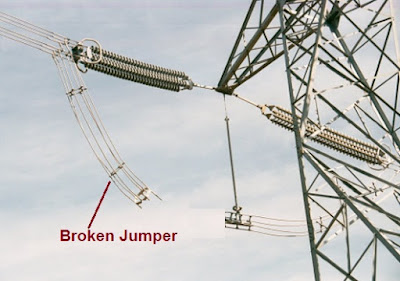The majority of faults on a power system occur between one phase and ground or two phases and ground. These are known as shunt faults and arise from lightning discharges and other over voltages which initiate flashovers. Alternatively, they may arise from other causes such as birds on overhead lines or mechanical damage to cables etc. Such faults result in an appreciable increase in current and hence in the majority of applications are easily detectable. In Broken Conductor Protection, it is assumed that broken conductor do not touch the ground that is why, it is also known as the Open Jumper Protection.
It is possible to apply a negative phase sequence overcurrent relay to detect the above condition. However, on a lightly loaded line, the negative sequence current resulting from a series fault condition may be very close to, or less than, the full load steady state unbalance arising from CT errors, load unbalance etc. A negative sequence element therefore would not operate at low load levels.
The Broken Conductor Protection relay incorporates an element which measures the ratio of negative to positive phase sequence current (I2/I1). This will be affected to a lesser extent than the measurement of negative sequence current alone, since the ratio is approximately constant with variations in load current. Hence, a more sensitive setting may be achieved.
In the case of a single point earthed power system, there will be little zero sequence current flow and the ratio of I2/I1 that flows in the protected circuit will approach 100%. In the case of a multiple earthed power system (assuming equal impedances in each sequence network), the ratio I2/I1will be 50%.
It is possible to calculate the ratio of I2/I1 that will occur for varying system impedances, by referring to the following equations below.
I1F = Eg(Z1+ Z0) / (Z1Z2+Z0Z1+Z2Z0)
I2F = -EgZ0/ (Z1Z2+Z0Z1+Z2Z0)
Where
Eg = System Voltage
Z0 = Zero sequence impedance
Z1 = Positive sequence impedance
Z2 = Negative sequence impedance
Thus,
I1F / I2F= Z0 / (Z0+Z2)
Therefore, for an open circuit in a particular part of the system, I2/I1 can be determined from the ratio of zero sequence to negative sequence impedance. It must be noted that this ratio may vary depending upon the fault location. It is desirable therefore to apply as sensitive a setting as possible. In practice, this minimum setting is governed by the levels of standing negative phase sequence current present on the system. A minimum value of 8% negative phase sequence current is required for successful Broken Conductor relay operation.
Since sensitive settings have been employed, it can be expected that the element will operate for any unbalance condition occurring on the system for example, during a single pole autoreclose cycle. Hence, a long time-delay is necessary to ensure co-ordination with other protective devices. Normally 5 second time-delay is provided for Broken Conductor Protection.

What is phase sequence??is there Any article on this?? On ur website???
It is basically the sequence in which R,Y and B phase currents attain their maximum values.